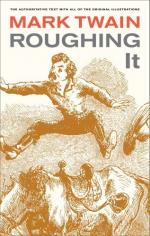At night they feasted and the girls danced the lascivious hula hula—a dance that is said to exhibit the very perfection of educated notion of limb and arm, hand, head and body, and the exactest uniformity of movement and accuracy of “time.” It was performed by a circle of girls with no raiment on them to speak of, who went through an infinite variety of motions and figures without prompting, and yet so true was their “time,” and in such perfect concert did they move that when they were placed in a straight line, hands, arms, bodies, limbs and heads waved, swayed, gesticulated, bowed, stooped, whirled, squirmed, twisted and undulated as if they were part and parcel of a single individual; and it was difficult to believe they were not moved in a body by some exquisite piece of mechanism.
Of late years, however, Saturday has lost most of its quondam gala features. This weekly stampede of the natives interfered too much with labor and the interests of the white folks, and by sticking in a law here, and preaching a sermon there, and by various other means, they gradually broke it up. The demoralizing hula hula was forbidden to be performed, save at night, with closed doors, in presence of few spectators, and only by permission duly procured from the authorities and the payment of ten dollars for the same. There are few girls now-a-days able to dance this ancient national dance in the highest perfection of the art.
The missionaries have christianized and educated all the natives. They all belong to the Church, and there is not one of them, above the age of eight years, but can read and write with facility in the native tongue. It is the most universally educated race of people outside of China. They have any quantity of books, printed in the Kanaka language, and all the natives are fond of reading. They are inveterate church-goers —nothing can keep them away. All this ameliorating cultivation has at last built up in the native women a profound respect for chastity—in other people. Perhaps that is enough to say on that head. The national sin will die out when the race does, but perhaps not earlier.—But doubtless this purifying is not far off, when we reflect that contact with civilization and the whites has reduced the native population from four hundred thousand (Captain Cook’s estimate,) to fifty-five thousand in something over eighty years!
Society is a queer medley in this notable missionary, whaling and governmental centre. If you get into conversation with a stranger and experience that natural desire to know what sort of ground you are treading on by finding out what manner of man your stranger is, strike out boldly and address him as “Captain.” Watch him narrowly, and if you see by his countenance that you are on the wrong tack, ask him where he preaches. It is a safe bet that he is either a missionary or captain of a whaler. I am now personally acquainted with seventy-two captains and ninety-six missionaries. The captains and ministers form one-half of the population; the third fourth is composed of common Kanakas and mercantile foreigners and their families, and the final fourth is made up of high officers of the Hawaiian Government. And there are just about cats enough for three apiece all around.




